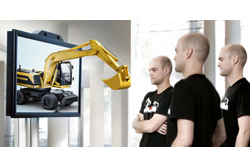Europe's online source of news, data & analysis for professionals involved in packaged media and new delivery technologies

Berlin institute pushes viewer-friendly 3D autostereoscopic technology
Berlin-based Fraunhofer Heinrich Herts Institute (HHI) demonstrated at IFA a 3D glasses-free system that goes a long way to solving the inherent problem associated with autostereoscopic method, namely, that optimization of the 3D experience depends on the position of the viewers facing the 3D screen.
Autostereoscopic viewing technology developed by Fraunhofer HHI uses special software and a strip grid glass plate mounted at a 70-degree angle in front of the screen to ensure that both images or image streams reach the viewer’s eyes.
To ensure viewers can view 3D from any position in front of the 3D television without being troubled by double outlines, scientists there have coupled a 3D display with a technology called “head tracking.” This involves a camera which registers the exact position of the eyes and uses this information to modify the direction of the image stream and thus continually refresh the picture content.
In this “Singleview Mode” one single person can experience 3D without auxiliary eyewear while being able to move to the left and right in front of the screen. In the “Multiview Mode” several viewers can simultaneously watch three-dimensional TV from a variety of positions in front of the display.
Furthermore, in the “Wide Lobe” mode one person can view 3D while two people standing one on the right and one on the left can watch in 2D. Lastly, with the “Multi Content” mode, two people can watch different types of content in 3D on the same screen.
The Fraunhofer institute reckons this last mode of viewing will be critical for the future of the computer game industry.
Story filed 09.09.10




















